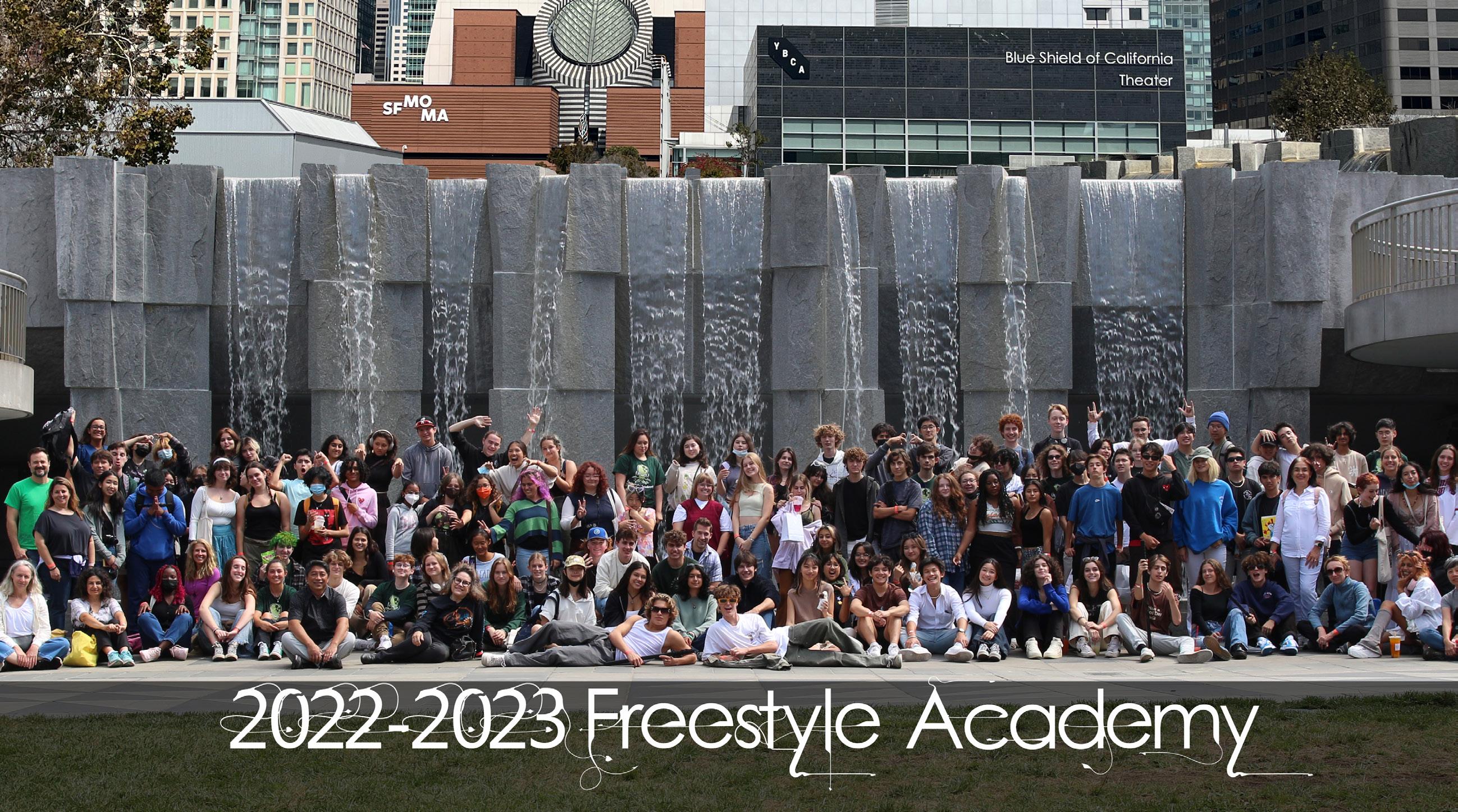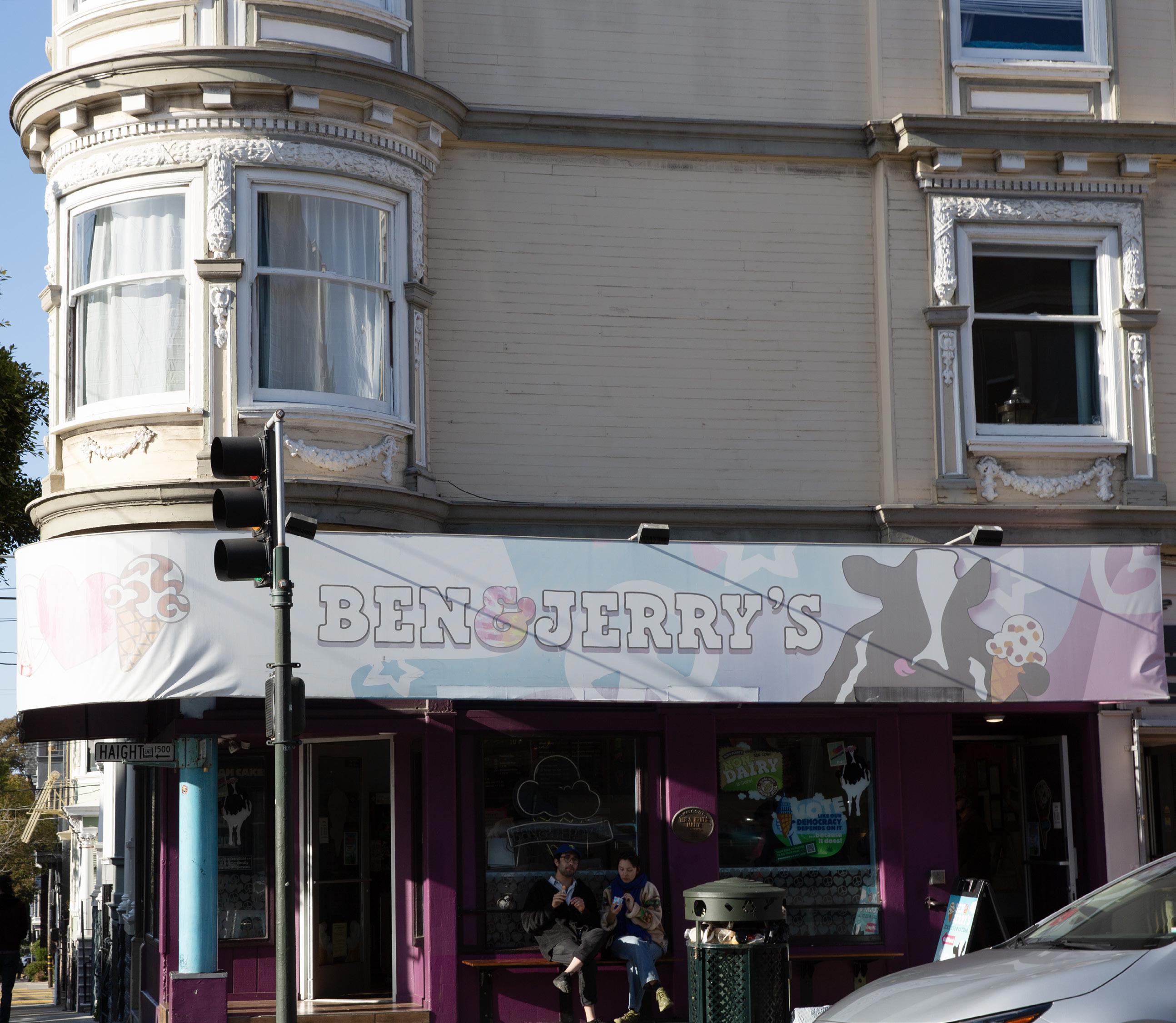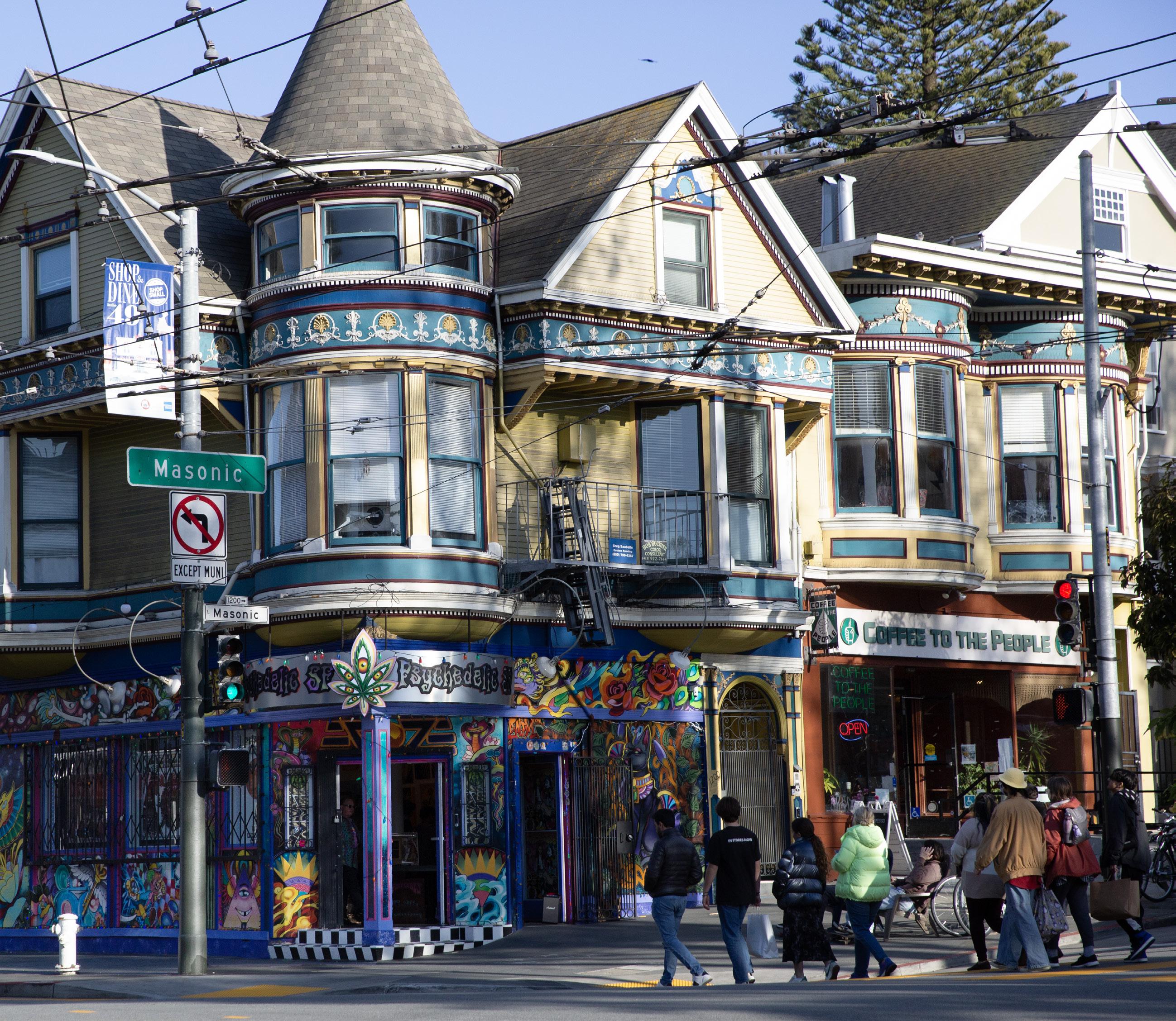Voices of Haight-Ashbury
 Avani Chhabra
Avani Chhabra

 Avani Chhabra
Avani Chhabra

To my parents for supporting and funding my creativity

I am grateful to all of those who supported me throughout this project, including my Freestyle peers and teachers, Mr. Florendo, Mrs. Parkinson, and Mr. Greco. I would also like to thank Mendel’s Crafts, Pam and Bruce Brennan, and Tara Monks for their willingness to participate in my documentary and share their experiences about Haight-Ashbury. Finally, I would like to thank my friends and family for their support and encouragement.

The Haight-Ashbury neighborhood of San Francisco has long been synonymous with the hippie movement of the 1960s. From its vibrant street culture and psychedelic music scene to its counter cultural values and experimentation with drugs, the Haight was a haven for those seeking an alternative to mainstream American society. Today, the neighborhood is undergoing a new transformation, one that has been driven by gentrification, rising housing costs, and the displacement of long-time residents. The oncebohemian Haight is now a tourist destination, a place where visitors can buy tie-dyed shirts. I believe that Haight-Ashbury is more than just a tourist attraction or a relic of the past. It is a vibrant community with a storied history, a place where creativity and experimentation continue to thrive in the face of adversity.

Wear some flowers in your hair! Rock some tie-dye! Promoting openness and opposing society’s restrictions and conformity, the people of the hippie movement in the late 60s and 70s were looking for new ways to express themselves. They wanted to live simply. Seeking to create long lasting change, hippies rebelled against commercialism, the status quo, and the war in Vietnam. What was once the center of the hippie movement, the Haight-Ashbury district—simply known as the Haight—was filled with vibrance, Victorian architecture, and activism. Today, it is a completely changed place, having suffered the aftershocks of the Summer of Love (a counterculture hippie movement during the summer of 1967)
and commercialization. The bright colors and symbols of the movement remain.
Booming tourism has been a doubleedged sword for the Haight. On the positive side, tourism brings in a significant amount of money to the area through increased business activity, job opportunities, and tax revenue. Additionally, businesses promoting the cultural and historical significance of the Haight increases awareness and appreciation of the local arts and music scene, and fosters a sense of community pride. On the other hand, tourism has led to overcrowding, increased cost of living, and decreased diversity. The over-commercialization of the Haight-Ashbury district threatens its authenticity as a counterculture center and the uniqueness that draws people there.

Sibling tour guides and long-time residents Pam and Bruce Brennan were involved in activism during the 70s, and currently give tours of the Haight. When he was in high school, Bruce was at a peace march protesting the war in Vietnam and got arrested. It hit the papers, and school authorities were not impressed and accused his mom of being negligent when she was right next to him at the peace march. He would also wear and sell peace buttons that said ‘Bombs, Bullets, and Bullshit’, and the conventional school that he went to thought he was a bad influence. While he got mail from supporters from the news about the peace march saying that he was such a hero, and thanks for the commitment to stop the war, etc, he also got hate mail saying things like ‘If you don’t like America get your ass out’, which was a common phrase used at the time against protesters and people who were against the war.
Bruce tried to move to Canada, where he built a geodesic dome (sustainable architecture in which it enclosed the same amount of space as a conventional building, but for 1/3 the cost due to the stronger structure
of it), but unfortunately had visa issues and he ended up finishing high school at this alternative school in Santa Cruz, Pacific High School.
Kids were free to go wherever they wanted to go, as long as they were being educated in some fashion, even on school days. They would often go to the beach and see sea life, and just walk through the woods. One time, Bruce and his peers were on the beach and got asked by police questioning what they were doing at the beach (asking why they were not at school). They said they were in class, and the police responded asking where is the teacher, and they said the teacher is the sea. His physical education consisted of swimming naked in the lake, and physics class was welding an enormous yellow submarine, and seeing how much water it displaced. Their mom was involved in activism, and Pam elaborates how later she became part of it, “Well you can’t hear about the 60s from just anybody, but I was there, in the middle of a lot of it. And my mom was real active, my two brothers were active and as young as I was, therefore I was active.”
Pam needs tourism for her business as a tour

guide and inn to survive, but how much does it actually affect her and other locals? She elaborates how, “There could have been less dramatic change in that regard [tourism] as we have lost a lot of local stores that were essential.” Pam also discusses the concept of “Yuppies” (young, upwardly mobile professionals), like people who work at big tech companies. She emphasizes how this category of people try to say they are hip and live in the Haight-Ashbury neighborhood, but are not sustainable and do not do anything to help the environment. Hippies were the opposite:
working unconventional jobs, practicing sustainable living, and overall counterculture. Yuppies increased the price of rent and housing, and after the fall of the hippie movement, displaced the hippies. Additionally, the rise of yuppies coincided with a period of economic instability, which may have contributed to a widening wealth gap and increased homelessness. Yuppies are characterized by their materialism, consumerism, and focus on career success. According to the urban studies blog Proto City, “Because the Haight-Ashbury district evolved into a predominantly minority-
“There could have been less dramatic change in that regard [tourism] as we have lost a lot of local stores that were essential.”
“... visitors may pick up the impression today’s Haight Street is a movie set designed around the Summer of Love. A local who has lived on Ashbury Street since the 1970’s complained the neighborhood’s businesses now revolve around tourists rather than residents.”
run neighborhood, rent remained affordable to tenants” (“From Hippies to Hipsters”). San Francisco is one of the most gentrified cities, experiencing that change rapidly after the decline of the hippie movement, and the city itself is not helpful to homelessness. As the LA Times reports, “... its result is spiraling housing costs, clogged traffic, an exodus of middle-class and poor families and declining black and Latino populations” (Morain). Similar to the hippie movement, homelessness is now distinguishing the area of Haight-Ashbury.
The business cycle in the Haight is very cyclical, according to Naomi Silverman and what she has seen from her time running Mendel’s Crafts as businesses come and go. There are often resurgences in certain types of stores, like the recent vintage clothing stores popping up in the Haight. However, the recent presence of national chains such as Ben and Jerry’s and Whole Foods in Haight-Ashbury could be seen as a sign of commercialization and gentrification in the area. These companies are part of larger corporate entities and are associated with mainstream, middle-class consumer culture showing the increase of yuppies in the area, which does not align with the counterculture history and values of Haight-Ashbury. Some may see them as a positive sign of economic growth and development, while others view
them as a threat to the neighborhood’s authenticity and character. Tara Monks, student at the Urban School of San Francisco, has observed how there is a line of people in Ben and Jerry’s on the weekends, taking pictures with the Haight-Ashbury street signs. Often locals believe that tourism is ruining the authenticity of the Haight-Ashbury, as the whole hippie movement was about counterculture, and these corporations introduce mainstream culture to the Haight. However, “... visitors may pick up the impression today’s Haight Street is a movie set designed around the Summer of Love. A local who has lived on Ashbury Street since the 1970s complained the neighborhood’s businesses now revolve around tourists rather than residents” (“Revisiting San Francisco’s Haight”). Increased tourism can lead to the commercialization of the neighborhood, with businesses catering to tourists and losing sight of the unique cultural and historical character of the neighborhood. Haight-Ashbury was also primarily a minority run neighborhood before the Summer of Love, which commercialization threatens. Pam’s personal reason for moving to San Francisco was for the diversity, as she previously lived in New York, an area similar to SF. In recent days, she notes, it has definitely been more white than in the past. (P. Brennan)

One of the primary issues in HaightAshbury is the high cost of rent and housing. The neighborhood is in a prime location, and as a result, the demand for housing is high, leading to steep prices that can be unaffordable for many residents. Additionally, the neighborhood has a high rate of homelessness, which stems from a variety of factors, including the lack of affordable housing, mental illness, and drug addiction.
For other businesses, housing and rent proved to be a bigger issue. Rasputin Music was a beloved music store that had been a fixture in the Haight-Ashbury neighborhood for decades. It was announced that the store would be closing its doors due to a number of factors, including declining sales in physical media and the rise of digital streaming services; indeed, the demise of Rasputin was part of the trend of longtime businesses’ shutting down in San Francisco (Li). The closure of Rasputin Music is also indicative of the broader challenges facing small businesses in the wake of the pandemic. Many small businesses have struggled to stay afloat due to reduced foot traffic, changing consumer habits, and other factors. This has had a significant
impact on the character of neighborhoods like Haight-Ashbury, which rely on small businesses to create a sense of community and identity.
As an art and fabric store that has been there since 1968, Mendel’s Crafts proves that it’s possible to survive as a business on Haight without catering to the Hippie aesthetic that draws some tourists. For Mendel’s, housing was less of an issue. Naomi Silverman, current owner of the store, had her biggest challenges with the local homelessness and COVID. Since Mendel’s Crafts has existed since 1968, Naomi is able to maintain her customers. She also finds that each neighborhood in San Francisco is so unique and different, and that local residents tend to stay in their respective neighborhoods. Mendel, Naomi’s grandfather, owned the building and started the business, later passing it down. Currently, her family still owns the building, meaning rent is not an issue (Silverman).
Gentrification with newer developments and higher price options generally displaces long time residents. The Haight-Ashbury neighborhood has one of the highest concentrations of airbnbs in San Francisco (Neilson). Why that occurs is partially because

of the Victorian-style architecture in the Haight, as well as its close proximity to other tourist attractions, like the Golden Gate Park. However, many long term residents are saying it affects the character and community of the neighborhood. One concern is that Airbnb can contribute to rising housing costs and gentrification, as landlords may choose to convert long-term rentals into short-term vacation rentals in order to make a higher profit. This can reduce the availability of affordable housing for long-term residents and contribute to the displacement of lower-income residents in the Haight.
Tara Monks, a current senior at the Urban School of San Francisco (the high school on Haight), discusses their schooling and thoughts on the neighborhood. As a private school in an area with significant homelessness, there is discourse of how it affects HaightAshbury and its surrounding neighborhood. Tara mentions that in the process to expand the Urban School, it has destroyed three neighboring apartment buildings. There are also students at the private school moving into the neighborhood who have the ability to pay significantly more for property as compared to long-time residents. Tara emphasizes that the
Previous Page: Whole Foods Market in the Haight
school does put in the effort to educate new students about the local homeless population, however, “ … it still feels very disconnected because you got kids paying almost $60,000 to go to this private school. And then people who don’t have like a physical place to stay each night one block away and … it’s really strange” (Monks).
“ … it still feels very disconnected because you got kids paying almost $60,000 to go to this private school. And then people who don’t have like a physical place to stay each night one block away and … it’s really strange.”

As the epicenter of the hippie movement, the legacy of the Haight is still alive today. While the hippie movement has evolved over the years, its spirit endures in several ways. Certain businesses may be more known than others if one was to think of the
commonplace, everyday stores. It may surprise you to find out that businesses that have lasted have been the opposite of such “staples,” such as Mendel’s Crafts, Robert’s Hardware, and Gus’ Community Market. The Haight-Ashbury Food Conspiracy also offered an alternative way
hippie movement, like record stores, vintage clothing wear, smoke shops, etc. Often these stores are considered staples of the hippie movement, but the most resilient are the
to get groceries. During Pam’s five-year tenure at the co-op,. members would get groceries from farms and would have a center to distribute them to locals for 1/3 the cost of regular
“The rejection of traditional values and embracing of free love, drugs, and music continues to shape today’s youth culture.”

groceries. While the Food Conspiracy is now closed, these other local gems continue the Haight-Ashbury legacy, and the spirit of the 60s lives in the local community.
Pam and Bruce Brennan still help out where they can and advocate for sustainability to anyone that comes to their tours. Pam is also not afraid to correct people if she hears misinformation, as she discusses how a lot of people want to pretend the Haight-Ashbury hippie years never existed and the real estate agents especially due to the drugs, and are trying to rename different parts of the neighborhood. For instance, when she went out to lead the tour one day, Pam heard a real estate agent telling a prospective buyer that the area they were in was SOPA (South of the Panhandle). She then corrected him: HaightAshbury is the proper name. Later on he sent a postcard weeks later saying give Haight a chance, as she said he should speak positively about what happened here.
What is the legacy of the hippie movement and what was left behind by it? There are several landmarks and institutions that pay tribute to the hippie movement in HaightAshbury. For example, the Haight-Ashbury Free Clinic, founded in 1967, continues to
provide free healthcare services to those in need. In addition, the Haight-Ashbury Street Fair, which began in 1978, is an annual event that celebrates the neighborhood’s history and culture. The fair features live music, food vendors, and booths selling handmade crafts and clothing. Overall, the legacy of the hippie movement can still be felt in the Haight-Ashbury today, as the neighborhood continues to celebrate its counterculture roots and promote a message of peace, love, and community.
Moreover, “The rejection of traditional values and embracing of free love, drugs, and music continues to shape today’s youth culture.” (“Hippies to Yuppies. What Happened?”)
Previous Page: Pam Brennan showing her sign for protesting

Understanding the story of the Haight and its struggles with gentrification and homelessness is important for several reasons. Firstly, the Haight is a symbol of the counterculture movement of the 1960s and its legacy. As such, it has cultural and historical significance beyond its physical boundaries. Secondly, the changes that the Haight has undergone in recent years are indicative of broader issues of gentrification and displacement that are affecting many urban neighborhoods across the country. By studying the story of Haight-Ashbury, we can gain insights into larger social and cultural movements and better understand the forces that shape our cities and communities. We can also learn from the successes and failures of the past in order to create more inclusive, equitable, and sustainable urban environments. Furthermore, Haight-Ashbury remains a source
of inspiration for artists, musicians, and activists who continue to draw from the values and ideals of the counterculture movement. Pam expresses how, “It was an amazing time and it gave a lot of us the notion that we could change the world.” The legacy of Haight-Ashbury can be seen in the ongoing struggles for social justice, environmental sustainability, and creative expression that continue to shape our world today.
By understanding the challenges facing the Haight, we can gain insight into the larger forces at work that are impacting the fabric of our cities and communities. Haight-Ashbury is often put in perspective as a reflection of what is going on in San Francisco as a whole, as Naomi points out. When places of a cultural significance gain national traction, new changes are bound to come about, positive and negative.

Whiting, Sam. “These Renderings Show What Housing at Former McDonald’s Site in Haight-Ashbury Could Look Like.” San Francisco Chronicle, 9 Feb. 2023, https://www.sfchronicle.com/bayarea/article/san-francisco-affordable-housing-17775098.php.
Neilson, Susie. “Why This Neighborhood Has the Most Airbnbs of Any San Francisco Residential Area.” San Francisco Chronicle, 18 July 2022, https://www.sfchronicle.com/sf/article/ airbnb-neighborhood-17300941.php.
Li, Roland. “Rasputin Music to Close Record Store in Haight-Ashbury.” San Francisco Chronicle, 9 Nov. 2019, https://www.sfchronicle.com/business/article/Rasputin-Music-toclose-record-store-in-14821734.php#:~:text=Rasputin%20management%20did%20not%20 respond,need%20for%20earthquake%2Dsafety%20retrofitting.
Guerrero, Susana. “A Vintage Clothing Store Will Replace Former Rasputin Music Space in San Francisco.” SFGATE, 23 Dec. 2019, https://www.sfgate.com/business/article/haightrasputin-new-tenant-sf-14881847.php.
davidstone1313. “Hippies to Yuppies. What Happened? – Roosevelt Island, New York...” Roosevelt Island, New York, Daily News, 26 Jan. 2023, https://rooseveltislanddaily. news/2023/01/26/hippies-to-yuppies/.
“From Hippies to Hipsters and Homelessness in Haight-Ashbury.” TheProtoCity.com, 5 Dec. 2018, http://theprotocity.com/from-hippies-to-hipsters-and-homelessness-in-haight-ashbury/.
David and Kay Scott CNHI News Service. “Revisiting San Francisco’s Haight, Ashbury Streets Five Decades Later.” The Daily Star, 11 Apr. 2020, https://www.thedailystar.com/news/ lifestyles/revisiting-san-franciscos-haight-ashbury-streets-five-decades-later/article_1b905411d5c6-5dcd-9d74-0a7865b67116.html.
davidstone1313. “The History of the Hippie Movement and Its Impact on Soci-
ety –...” Roosevelt Island, New York, Daily News, 20 Apr. 2022, https://rooseveltislanddaily. news/2022/04/20/the-history-of-the-hippie-movement-and-its-impact-on-society/.
“Gentrification’s Price : S.F. Moves: Yuppies in, the Poor Out.” Los Angeles Times, Los Angeles Times, 3 Apr. 1985, https://www.latimes.com/archives/la-xpm-1985-04-03-mn-28445-story.html.
Brennan, Pam. Personal interview. 23 Feb 2023.
Brennan, Bruce. Personal interview. 23 Feb 2023.
Monks, Tara. Personal interview. 22 Mar 2023.
Silverman, Naomi. Personal interview. 23 Feb 2023.
“Born in the Summer of Love: The Haight Ashbury Free Clinic Transformed Drug Addiction Treatment.” Born in the Summer of Love: The Haight Ashbury Free Clinic Transformed Drug Addiction Treatment | UC San Francisco, 3 May 2023, https://www.ucsf.edu/news/2017/06/407286/bornsummer-love-haight-ashbury-free-clinic-transformed-drug-addiction.
“About HASF.” HASF, https://www.haightashburystreetfair.org/abouthasf.
Kaye, Michael S. The Teacher Was the Sea; the Story of Pacific High School. Crisp Publications, 1989.
Avani Chhabra is a junior at Mountain View High School and is studying Design at Freestyle Academy. She was born and raised in California, and plans on going into Psychology and Design. She spends most of her time with her family and friends, and when she isn’t doing that, you can find her traveling, drawing, listening to music, and running in track and field. Avani’s current favorite artist is Mac Miller, and you can often spot her at the beach.

